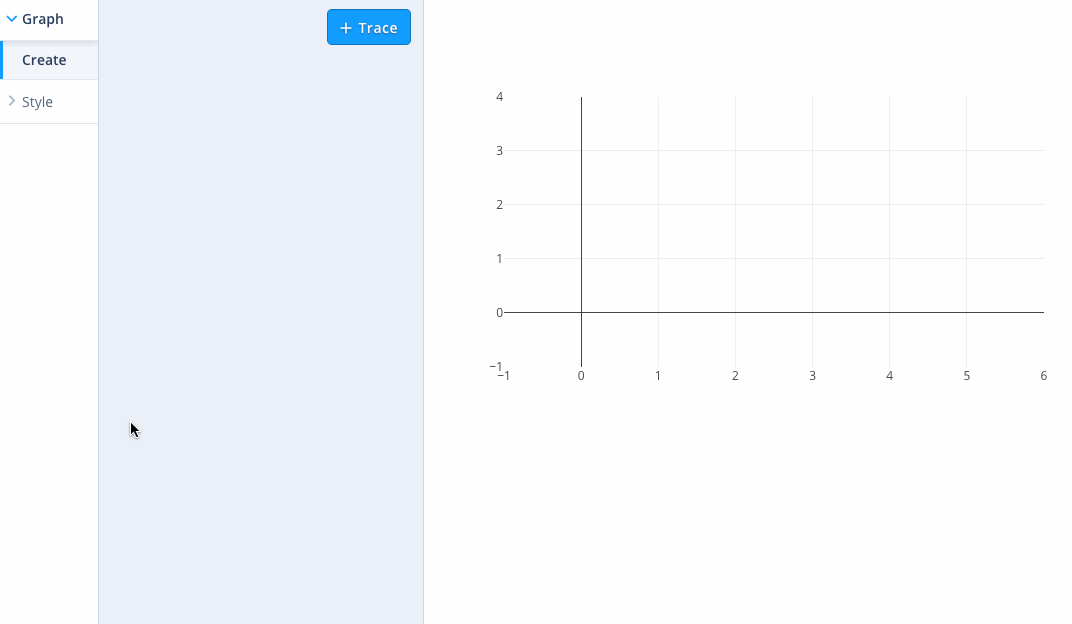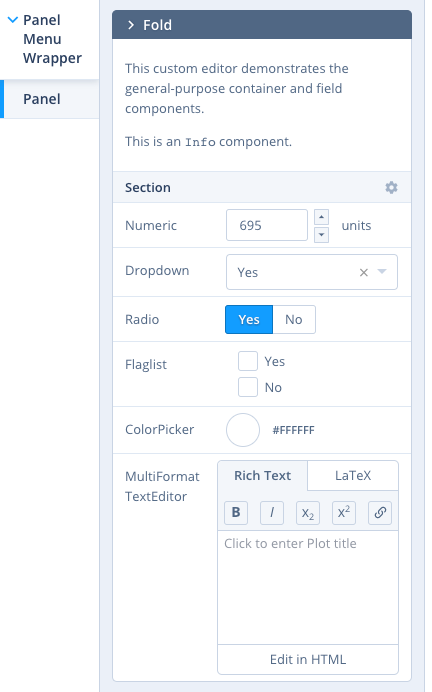Customizable React-based editor panel for Plotly charts
Check out the live demo here.
Check out the demo of the DefaultEditor at https://plotly.github.io/react-plotly.js-editor/ or run it locally with:
git clone [this repo]
cd react-plotly.js-editor
cd examples/simple
npm install
npm start
See more examples here.
This module's entry point is a React component called <PlotlyEditor /> which connects to a plotly.js-powered <Plot /> component care of react-plotly.js. A plotly.js plot is defined by a JSON-serializable object called a figure. <PlotlyEditor /> accepts as children React components whose descendents are input elements wrapped via connectToContainer() calls so as to bind them to the <Plot />'s figure's values. If no children are passed to the <PlotlyEditor />, the <DefaultEditor /> is used. This module also exposes the building block components that comprise the <DefaultEditor /> so that developers can create their own customized editors.
The binding between <PlotlyEditor /> and <Plot /> works a little differently that in most React apps because plotly.js mutates its properties. This is mapped onto React's one-way dataflow model via event handlers and shared revision numbers which trigger re-renders of mutated state. The following subset of the simple example shows how this works using a parent component to store state, but the principle is the same with a different state-manage approach, as shown in the redux example:
import PlotlyEditor from 'react-plotly.js-editor';
import Plot from 'react-plotly.js';
class App extends Component {
constructor() {
super();
this.state = {graphDiv: {}, editorRevision: 0, plotRevision: 0};
}
handlePlotUpdate(graphDiv) {
this.setState(({editorRevision: x}) => ({editorRevision: x + 1, graphDiv}));
}
handleEditorUpdate() {
this.setState(({plotRevision: x}) => ({plotRevision: x + 1}));
}
render() {
return (
<div>
<PlotlyEditor
graphDiv={this.state.graphDiv}
onUpdate={this.handleEditorUpdate.bind(this)}
revision={this.state.editorRevision}
{...snip}
/>
<Plot
data={this.state.graphDiv.data}
layout={this.state.graphDiv.layout}
onUpdate={this.handlePlotUpdate.bind(this)}
revision={this.state.plotRevision}
{...snip}
/>
</div>
);
}
}<PlotlyEditor /> accepts a dataSources property which is an object of arrays of data, as well as a dataSourceOptions property which contains metadata about the dataSources, such as human-readable labels used to populate input elements like dropdown menus. <PlotlyEditor /> treats these properties as immutable so any changes to them will trigger a rerender, and accepts an onUpdateTraces event handler property which is called whenever it needs to access a column from dataSources, enabling asynchronous data loading e.g. from remote APIs. The async-data example shows how this is done using a dummy asynchronous back-end proxy.
- Import editor styles with
import react-plotly.js-editor/lib/react-plotly.js-editor.min.css - Interested in theming?
- Need to support IE11? import the IE css instead:
import react-plotly.js-editor/lib/react-plotly.js-editor.ie.min.css
You can use npm link to link your local copy of the react-plotly.js-editor to your test repo.
With npm link you can get some errors related to
multiple copies of react being loaded.
To get around this, you can create an
alias that
points your project to the copy of react that it should be using or you can
simply remove react and react-dom from react-plotly.js-editor.
In one terminal:
npm link # registers react-plotly.js-editor for subsequent npm link calls
npm run watch # keep this running
In another terminal:
cd examples/simple # or any other application directory
npm install
rm -rf node_modules/react node_modules/react-dom node_modules/react-plotly.js-edit
npm link react-plotly.js-edit
npm start # keep this running
This module provides a number of nestable containers which are intended to contain fields that render widgets that have been connected to individual values in the figure via connector functions. Containers can also be connected to parts of the figure tree (e.g. layout or specific traces in data) such that their child fields map to the appropriate leaf values. A field must have a connected container as an ancestor in order to be bound to the figure. The <PlotlyEditor /> and connector functions use the React context API to push configuration information to child components.
At a pseudo-code level it looks like this:
<PlotlyEditor {...etc}>
<ConnectedContainer {...etc}>
<Field attr="path.to.figure.value" {...etc} />
</ConnectedContainer>
</PlotlyEditor>The custom editor example shows how to build a custom editor, and shows off all of the general-purpose containers and fields listed below.
-
<Panel />: renders as a generic rectangular container with special handling for collapsing/expanding child<Fold />s and optionally an 'add' button for creating them -
<PanelMenuWrapper />: renders as a sidebar selector menu for<Panel />s -
<Fold />: collapsable container within a<Panel /> -
<Section />: uncollapsable container within a<Panel />or<Fold /> -
<MenuPanel />: container child of<Section />that appears when a cog icon in the section title is clicked on
All Fields except <Info /> accept an attr property to bind them to a key in the figure (see https://plot.ly/javascript/reference/ for exhaustive documentation of figure keys). This property can be a .-delimited path to a leaf, starting at the context-appropriate point in the figure for the parent container (see connector functions below).
-
<Info />: renders its children as HTML, useful for displaying help text -
<Numeric />: renders as a text field with arrows and units, useful for numeric values -
<Radio />: renders as a button group, useful for mutually-exclusive low-cardinality enumerable values -
<Dropdown />: renders as a dropdown menu useful for mutually-exclusive high-cardinality enumerable values -
<ColorPicker />: renders as a popup color-picker, useful for CSS color hex value strings -
<Flaglist />: renders as a list of checkboxes, useful for+-joined flag lists likedata[].mode -
<MultiFormatTextEditor />: renders as a WYSIWYG editor, useful for text likelayout.title
-
<TraceAccordion />:<Panel />whose children are replicated into<Folds />connected to traces viaconnectTraceToPlot(). -
<LayoutPanel />:<Panel />whose children are connected to thelayoutfigure key -
<TraceRequiredPanel />:<LayoutPanel />renders<PanelEmpty />if no trace data is set -
<AnnotationAccordion />:<Panel />whose children are replicated into<Folds />connected to annotations viaconnectAnnotationToLayout(). For use in a<LayoutPanel />. -
<AxesFold />:<Fold />whose children are bound to axis-specific keys. For use in a<LayoutPanel />in concert with<AxesSelector />(see below). -
<TraceMarkerSection />:<Section />with trace-specific name handling. For use in containers bound to traces e.g. as children of<TraceAccordion />.
For use in containers bound to traces e.g. as children of <TraceAccordion />:
-
<DataSelector />: renders as a<Dropdown />coupled todata[].*srcetc, triggersonUpdateTraceswhen changed -
<TraceSelector />: renders as a<Dropdown />useful fordata[].type -
<LineDashSelector />: renders as a<Dropdown />useful fordata[].line.dash -
<LineShapeSelector />: renders as a<Dropdown />useful fordata[].line.shape -
<SymbolSelector />: renders as a<Dropdown />useful fordata[].marker.symbol -
<LayoutNumericFraction />and<LayoutNumericFractionInverse />: renders as a<Numeric />for use in trace-connected containers where normal<Numerics />would be bound to thedatakey instead of thelayoutkey in the figure e.g.layout.bargaporlayout.barwidth.
For use in containers bound to layout:
-
<FontSelector />: renders as a<Dropdown />whose options are rendered in the selected font -
<CanvasSize />: renders as a<Numeric />with visibility coupled tolayout.autosize
For use in containers bound to axes:
-
<AxesSelector />: renders as a<Radio />to select one or all axes. Must be in a container bound to a figure viaconnectAxesToPlot()such as<AxesFold />and sets that container's context such that its children are bound to either all axes or just the selected one. -
<AxesRange />: numeric with visibility coupled tolayout.*axis.autorange
For use in containers bound to annotations e.g. as children of <AnnotationAccordion />:
-
<AnnotationRef />: renders as a<Dropdown />useful forlayout.annotations[].xref,layout.annotations[].yref -
<AnnotationArrowRef />: renders as a<Dropdown />useful forlayout.annotations[].axref,layout.annotations[].ayref -
<ArrowSelector />: renders as a<Dropdown />useful forlayout.annotations[].arrowhead
-
connectToContainer( Component ): returns a field component that can be bound to a figure value via theattrprop. -
connectTraceToPlot( Container ): returns a wrapped container component that can be bound to a figure trace such that its children are bound to that trace's figure entry under thedatakey, e.g.<TraceAccordion />below. -
connectLayoutToPlot( Container ): returns a wrapped container component that can be bound to a figure such that its children are bound to that figure's layout under thelayoutkey. -
connectAxesToLayout( Container ): returns a wrapped container component that should contain an<AxesSelector />field (see below) and can be bound to a figure such that its children are bound to that figure's axes entries under thelayout.*axiskeys. -
connectAnnotationToLayout( Container ): returns a wrapped container component that can be bound to a figure annotation such that its children are bound to that annotation's figure entry under thelayout.annotationskey, e.g.<AnnotationAccordion />below.
© 2017 Plotly, Inc. MIT License.

